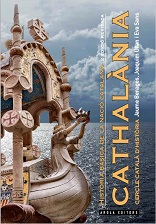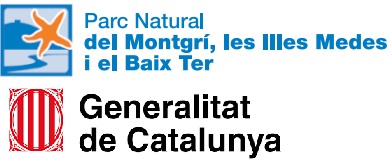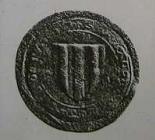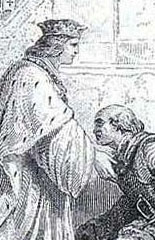At the celebration, attendees had the opportunity to explore the Nootka: Return to a Forgotten History exhibit at the Vancouver Museum, followed by a lecture with guest speaker René Chartrand, a Military Historian and former Chief Curator at Parks Canada.
Ms. Angelina Miró, the Casal Català de Vancouver's coordinator of the celebration, made the following speech:
THE ORIGINS
Pere d’Alberní i Texidor was born on January 30, l747 to a noble family, in the city of Tortosa, Catalonia, Spain. As all good Catholics back in those days, he was baptized practically as soon as he was born, (Since many newly-borns died suddenly in those days, the parents usually rushed to baptize them for fear that his soul would forever remain in the purgatory) in the Cathedral of Tortosa with the names "Pere, Jaume, Tomas, Joaquim, Josep".
His mother was Maria Ines Texidor and his father was Jaume d’Alberní i Antolí. His father was a notary public in Tortosa, a title that had been passed on from generations dating back to the 1600s. His father had also been granted the prestigious title of Honourable Citizen of Barcelona. Maria and Jaume had seven children: Five boys and 2 girls. The oldest brother Josep Antoni, and in accordance to Catalan civil law, was named heir to the Alberní state. This also included the right to use the title of Notary Public. The remaining siblings received a small amount of money. For this reason, the rest of the brothers joined the military service. One brother – Gerònim, went to the Regiment of Cordoba; the other two – Joan Bautista and Jaume Pascual, joined the Foreign Volunteer Regiment. One of the sisters became a nun. In those days, if you were not lucky enough to be named heir to an estate, the only future was in joining the military or the church. In Pere’s case, he opted for joining the military. He joined Spain’s Second Regiment of the Light Infantry in July 17,1762. At this time, he was only 15 years old and he remained with this regiment for five years, after which he joined the Free Company of the Volunteers of Catalonia (La Compañia Franca de los Voluntarios de Cataluña), the one with destination to America.
The Alberní family lived in a house, which was located in the centre of the city on a street named Plaça del Replà. The Alberní children had a happy childhood. They spent a lot of their time playing and swimming in the Ebro river, which crosses the entire city, and on occasions they even walked up to the Castle of Suda and played "moors and Christians" – the Christians of course, being the good guys. Like many families living in Catalonia in the 18th century, at home Pere and his siblings always spoke Catalan-Tortosi with their parents and with each other, while at school, the children were educated in Spanish.
Being a noble family, the Albernis had a sepulcher (or tomb) in the Cathedral of Tortosa. On the tomb one can, to this day, see the Family’s Coat of Arms and it is quite interesting. The upper left hand quarter has waves of water. The waves of water represent a brave spirit as well as loyalty to the sovereign (king). The upper right corner, has an image of two shaking hands. This represents friendship. The lower left corner has the sword and 3 crowns of the Aldanas. The sword represents justice and sovereignty of lineage. And finally, and perhaps the most interesting image is in the lower right corner, where one can see two superimposed spheres or medallions. One could interpret the spheres to signify the two hemispheres of the world or the New and Old Worlds coming together.
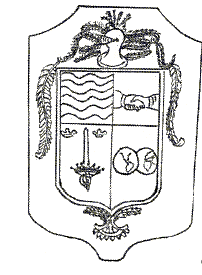
In many ways, the images found in the Alberní Coat of Arms, are symbolic of the work that Pere d’Alberni did throughout his life. He was sent to travel across the seas to the New World, where he befriended many helping to bring the New and Old Worlds together. Always of course, maintaining his loyalty to the King.
TORTOSA
The city where Pere d’Alberní was born, Tortosa is located in the province of Catalonia in the Northeast of Spain and it is over 2000 years old. Its first inhabitants were the Iberians, followed by the Romans (Dertosa), then by the Visigoths. In the times of the Visigoths, Tortosa became a very cosmopolitan city, flourishing with the influence of three major cultures – the Hebrew, Latin and Greek. When the Moors (Arabs) invaded Tortosa in 717, they began to promote culture and commerce. Tortosa was for centuries a very important port where wheat, salt and oil were shipped to Naples and Sicily. In order to protect the city from attacks, the Moors (Arabs) built a wall around Tortosa and also built the Castle of Suda, which became, as mentioned, one of the Alberni children’s favourite playgrounds.
In 1149 Tortosa was reconquered by the Christians, Ramón Berenguer IV, and in the 13th and 14th century they began the construction of the beautiful Gothic buildings such as the Cathedral, "La Lonja", and the Episcopal Palace, where in its archives one can find the most important church’s documents of the middle ages.
Today, Tortosa is a beautiful city. The Flag and Coat of Arms of the city are a castle with a red background. The mythological beast of Tortosa is a dragon called "Cucufera". Tortosa has the Virgin of the Ribbon and the Order of the Axe to give to a lady that does something nice for the city.
In order to honour Pere d’Alberní’s birthplace, in 1989, an exchange of flags took place between the city of Port Alberni and Tortosa. Ever since, the City Hall of Tortosa flies the flag of Port Alberní each January 30th. Port Alberní flies the flag of Tortosa each summer. In 1991, the crew of Juan Sebastian El Cano visited Port Alberní and unveiled two plaques from the Government of Spain and one from the Catalan government dedicated to Pere d’Alberní. In December 1994, the mayor of Tortosa visited Port Alberní for the first time and held a meeting and exchanged presents with the mayor of Port Alberní.
HIS LEGACY
Pere d’Alberní was a forty-year-career Spanish officer, he left an important legacy in Mexico, California and in British Columbia. He was in charge of the Volunteers of Catalonia in: Sonora, Nayarit, Guadalajara, Nootka Sound, Veracruz and the four military garrisons of California. The city of Port Alberní, in Vancouver Island, is named after him. He also has a street (Alberní Street) named after him in Vancouver and in Tortosa.
When Alberní first joined the army as a cadet in July of 1762, he was sent to fight the campaing against Portugal. Five years later, in 1767, he joined the Free Company of the Volunteers of Catalonia, an independent militar unity. This time his mission would take him further from his native Spain. He was sent on a transatlantic journey with destination to the Spanish Colony of New Spain (now known as Mexico). The objective of this mission was to defend the northern frontier of New Spain from natives’ insurgencies (Provincias Internas del Norte de Nueva España). These provinces ran from Guanajuato to New Mexico and from Sonora to Texas. (Visitador Galvez, Marques de Ruby y Teniente General Juan Villalba, they were the ones that asked the Metropoli to sent the Company to help).
On May 27, 1767, Alberni with the Free Company of the Volunteers of Catalonia (Migueletes), began his journey to Veracruz, Mexico from the Port of Cadiz, Spain. The Company was comprised of 98 soldiers under the command of Captain Callis and three other Officials: Pere Fages, Pere d’Alberní, and Estevan de Vilaseca. They arrived to their destination in August of that same year.
After Veracruz, the Company was destined to Guayma, where they arrived on April 1768, after having crossed Mexico City, Tepic, and San Blas. The trip took almost one year from Barcelona to Guayma.
Shortly after arriving to Guayma, the Callis’s men, under the command of Coronel Domingo Elizondo, were sent to the Mexican province of Sonora to fight against the rebel natives (Pima and Seris) and participate in the seven invasions of Cierro Prieto. After successfully finishing this campaign, Alberní and the rest of the Company was sent to Mexico city and Guadalajara after that Alberní was for seven years commander in the province of Nayarit.
In 1772 the Company was divided in two: the first and the second one.
In 1782, Captain Callis died and Alberní was named Captain of the First Company of Volunteers and Pere Fages, his friend and fellow Catalan, was already Captain of the Second Company. Captain Fages en his men were from 1769 to 1774 in California under the commander of Gaspar de Portola. Pere Fages and Pere d’Alberni were the two great "PERES" of The Volunteers of Catalonia.
In 1789 he received an order from the Viceroy of New Spain to be ready to travel the Northwest Coast with his Company. They departed on January of 1790 with de Eliza’s expedition and they arrived at Nootka Sound on April of the same year. His mission was to rebuild the Fort and look after the Spaniards living in the Spanish Fort at Nootka Sound. He was there from 1790 to 1792. (2 years and 10 months)
The only blemish on his perfect military record of 40 years, was that he was placed under house arrest for 70 days. This happened on his way to Nootka Sound, for defending the rights of his men to be adequately dressed and armed and to be paid all the back-pay they were owed. Maybe for that reason, he did not get the job as Governor of California later on.
Alberní is the first known gardener of BC and of the Northwest Coast. He kept a meticulous record of the best crops that grew in the soil of the Northwest Coast. He was also known for his ability to brew beer from certain coniferous trees. He kept a detailed record of the climate in Nootka Sound making him the first weatherman of BC. He also acted as a linguist by recording approximately 633 words of the language of first nations of Nootka Sound and translating them into Spanish.
To gain the friendship of local Chief Maquinna he wrote the lyrics of a song and dedicated it to him. He then made his soldiers sing it every time they marched:
Maquinna, Maquinna, Maquinna
Is a great prince and our friend
Spain, Spain, Spain
Is a friend of Maquinna and Nootka.
When he left Nootka Sound he was named "Commander of Arms and Governor of Nootka" by the Spanish Monarchy. Everybody missed him greatly including Chief Maquinna who for a two years and 80 days had been his best friend.
The Spanish explorers Alejandro Malaespina, Bodega y Quadra (The 1792 Expedition of Limits), and the naturalist-scientist and author of Noticias de Nootka, José Mariano Moziño, all praised the skills and achievements of Alberní during his time in Nootka.
In July 1792, he was named Lieutenant Colonel and after his assignment in Nootka, he was sent to the Castle of San Juan de Ulúa ( 8 months), in Veracruz/Mexico as commander of the Fort and as Lieutenant –Coronel of the King for the Plaza de Veracruz. After that Alberni was in Guadalajara for two years. On April of 1796 he moved with his company (72 men) to California to take care of the Spanish military garrisons of San Francisco, Monterrey and San Diego. He founded a town called Villa Branciforte (later known as Santa Cruz). In 1800 he became the overall commander of the four military garrisons that Spain had in the whole of California (San Diego, San Francisco, Monterrey and Santa Barbara) and also Interim Governor of California in 1800.
Alberní died of dropsy at the age of fifty-five in Monterrey, California on March 11, 1802. He was buried at the Royal Chapel of San Carlos in Monterrey. Today, his remains probably lie under the highway that was built nearby some years ago, because his tomb had never been found.
Alberní’s will, dated December 16, 1801, leaves everything to his beloved wife, Juana Velez, a native of Tepic, Mexico. Unfortunately the only daughter they had died before him. Sargent Joaquin Tico from the V.of C. was in charge of his will.
POEM in Catalan and Spanish
Voluntaris catalans,
Tropa ligera y galana;
El floret dels catalans.
La ciutat fa anar a campanya.
Voluntaris catalans,
Tropa ligera y galana;
A la guerra, fadrinets,
Que la ciutat nos demana.
The Volunteers of Catalonia were not just military men they were settler and explorers too and I think that they still need to be recognize by Spain for all their hard work in America.
Angelina Miró
Coordinadora de la Comissió del Bicentenari de la mort de Pere d'Alberní.
"Celebrar la mort vol dir simplement una excusa per recordar aquells que han deixat una poderosa emprenta en la historia".
Isabel-Clara Simó

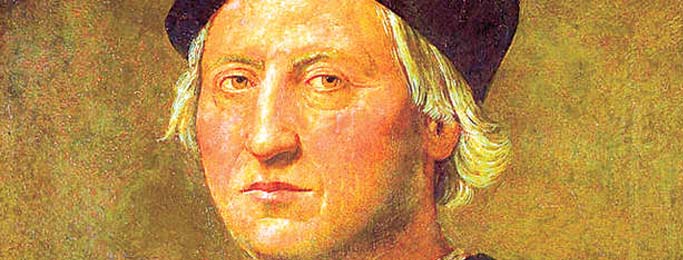
 El CCH
El CCH
